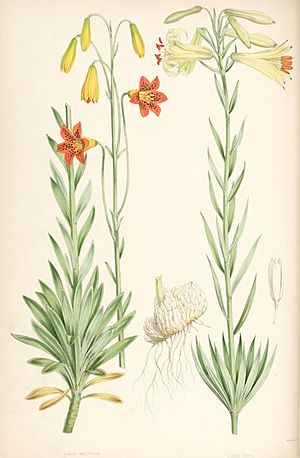Lilium parryi facts for kids
Quick facts for kids Lemon lily |
|
|---|---|
 |
|
| 1880 illustration | |
| Scientific classification | |
| Kingdom: | |
| (unranked): | |
| (unranked): | |
| Order: | |
| Family: | |
| Genus: | |
| Species: |
L. parryi
|
| Binomial name | |
| Lilium parryi S.Watson
|
|
| Synonyms | |
|
|
The lemon lily, also known as Lilium parryi, is a beautiful and rare wild flower. It's a special type of lily plant. This amazing plant is known for its bright yellow, trumpet-shaped flowers. It's a true treasure found in the southwestern United States and parts of northwestern Mexico.
Contents
Where the Lemon Lily Lives
The lemon lily loves moist places in the mountains. You can find it growing in the southwestern United States and northwestern Mexico.
In the United States
In California, this lily grows in the San Bernardino Mountains and San Gabriel Mountains. A few spots also remain near Palomar Mountain. It is the only true lily that naturally grows in Arizona. There, you can find it in the Huachuca Mountains, Chiricahua Mountains, and Santa Rita Mountains.
In Mexico
South of the border, the lemon lily has been found in the mountains of Sonora and Baja California in Mexico.
What the Lemon Lily Looks Like
The lemon lily is a perennial herb. This means it's a plant that lives for more than two years. It grows straight up to about 2 meters (over 6 feet) tall. It grows from a scaly, long bulb that can be up to 11 centimeters (about 4 inches) long.
Leaves and Flowers
The leaves are usually long and thin. They can be up to 29 centimeters (about 11 inches) long. They often grow in circles, called whorls, around the stem. The plant produces a flower cluster called a raceme. This cluster can hold up to 31 large, bright lemon yellow flowers.
The flowers are shaped like trumpets and smell very nice. Each flower has six petals, called tepals, that curl back. These tepals can be up to 11 centimeters long. Sometimes, they have a few reddish spots.
Pollination
The lemon lily flowers are pollinated by hawkmoths. These moths help the plant make seeds. Two types of hawkmoths that visit the lemon lily are Hyles lineata and Sphinx perelegans.
Protecting the Lemon Lily
The lemon lily is a rare species. It faces several challenges that make it hard for it to survive.
Threats to the Plant
- Grazing: Animals eating the plants can harm them.
- Recreation: Outdoor activities can sometimes disturb their habitat.
- Water Changes: Natural floods and human changes to water flow can affect where they grow.
- Collecting: People sometimes collect the bulbs and flowers. This can reduce the number of plants in the wild.
History and Celebration
The Lilium parryi was named after Charles Christopher Parry. He was a British-American botanist and mountaineer. He lived from 1823 to 1890.
In Idyllwild, California, there is a special event called the Lemon Lily Festival. This festival celebrates this unique and beautiful flower!

